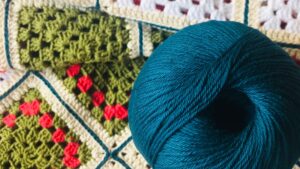Crocheting, a beautiful craft that weaves threads into intricate designs, often involves a finishing touch that can truly elevate your project’s appearance blocking. But what exactly is blocking in crochet, and why is it important? Let’s dive into this technique and unravel its significance.
What is Blocking in Crochet?
Blocking is a technique used to shape and set the final dimensions of a crochet piece. It involves dampening the finished project and then allowing it to dry in a specific shape. This process smoothens stitches, evens out tension, and enhances the overall look of your work.
Why Block Your Crochet Projects?
1. Polishing the Appearance
Blocking helps remove any unevenness in the stitches, giving your project a more polished and professional appearance.
2. Reshaping and Sizing
It allows you to reshape or resize items, ensuring they meet the desired dimensions and fit perfectly.
3. Opening Stitch Patterns
Complex stitch patterns often benefit from blocking as it helps define and open up intricate designs, showcasing the details beautifully.

4. Setting Yarn Fibers
Natural fibers, especially wool, tend to bloom and soften after blocking, enhancing the overall texture and feel of the piece.
How to Block Your Crochet Projects
1. Wet Blocking
- Submerge: Gently soak your finished piece in lukewarm water with mild detergent for about 15-20 minutes.
- Remove Excess Water: Press the piece between towels to remove excess water without wringing.
- Shape: Pin the item into the desired shape on a blocking board or mat.
- Dry: Allow it to air dry completely.
2. Steam Blocking
- Hover Steam: Hold a steam iron a few inches above the crochet piece without touching it, allowing the steam to penetrate the fibers.
- Shape: As the fibers become warm and pliable, shape the piece to your desired dimensions.
- Cool Down: Let it cool and dry in the desired shape.
Tips for Successful Blocking
- Choose the Right Method: Consider the yarn type and project to select between wet and steam blocking.
- Use Blocking Tools: Invest in blocking mats, T-pins, and blocking wires for precise shaping.
- Test with Swatches: Always test the blocking method on a swatch to ensure it achieves the desired result without damaging the yarn.
External Resources for Further Understanding
For additional insights into the art of blocking in crochet and enhancing your handcrafted creations, check out these valuable resources:
- Craft Yarn Council – Blocking Basics – Learn more about the basics of blocking and its significance in crochet projects.
- Interweave – All About Blocking Crochet – Explore comprehensive guidance on the various blocking techniques in crochet.
- The Spruce Crafts – How to Block Crochet – A step-by-step guide with visuals to assist you in perfecting the blocking process for your crochet pieces.
Blocking in crochet is a transformative technique that can truly elevate the beauty and finish of your handcrafted projects. By understanding its nuances and adopting the right approach, you can showcase your crochet creations in their best light, ensuring they stand out with finesse and elegance.
Overcoming Common Blocking Challenges
While blocking can significantly enhance your crochet projects, it may present a few challenges. Here are solutions to some common issues you might encounter:
1. Overstretching
- Solution: Use more pins to distribute the tension evenly while blocking. Allow the piece to dry completely before unpinning.
2. Wrinkles or Ridges
- Solution: Adjust the tension of the pins to smooth out wrinkles. Lightly mist the piece with water before pinning for better shaping.
3. Resistant Yarns
- Solution: For stubborn fibers, try a combination of wet and steam blocking methods or consult the yarn’s care instructions for specific guidance.
4. Lack of Blocking Supplies
- Solution: Improvise by using household items like towels, foam mats, and rust-resistant sewing pins if specialized blocking tools are unavailable.
Importance of Blocking for Different Crochet Projects
1. Garments
- Fit and Shape: Blocking ensures that garments fit as intended and hold their shape, making them more comfortable to wear.
2. Lacework
- Defining Stitches: It accentuates the intricate lace patterns, making them more defined and visually appealing.
3. Accessories
- Refinement: Blocking adds a touch of refinement to accessories like scarves and shawls, enhancing their drape and appearance.
Conclusion: Elevating Your Craft with Blocking
In the realm of crochet, blocking acts as the final flourish, transforming your handmade creations into polished masterpieces. Embracing this technique empowers you to refine stitchwork, perfect sizing, and showcase intricate details, ultimately adding finesse and allure to your projects.
Remember, practice makes perfect when it comes to blocking. Experiment with different methods, take cues from experienced crafters, and don’t hesitate to explore and innovate. With each project, you’ll master the art of blocking and witness the stunning transformation it brings to your crochet endeavors.
Unlock the true potential of your crochet pieces by harnessing the magic of blocking—a technique that amplifies craftsmanship, turning threads into timeless works of art.
External Links for Further Exploration
- Craftsy – The Importance of Blocking Your Crochet Projects – Delve deeper into understanding why blocking is crucial for crochet projects and how it can elevate your creations.
- LoveCrafts – Blocking Your Crochet Projects – Explore a comprehensive guide to blocking, including various methods and troubleshooting tips.
- Crochet Society – Masterclass: Blocking – Gain insights from experienced crocheters on the importance and techniques of blocking for stunning crochet projects.
Comparison tabular
| Aspect | Wet Blocking | Steam Blocking |
|---|---|---|
| Method | Involves soaking the finished piece in water | Utilizes steam to shape the crochet project |
| Process | Submerge in lukewarm water with mild detergent | Apply steam using an iron hovering above the crochet piece |
| Drying Time | Air dry after shaping on a blocking mat/board | Allow the piece to cool and dry in the desired shape |
| Effectiveness | Effective for natural fibers and delicate yarns | Suitable for stubborn fibers or intricate shaping needs |
| Shaping Precision | Moderate control over shaping with pinning | Greater control over shaping by manipulating heat and steam |
| Ease of Use | Simple process requiring soaking and pinning | Requires careful handling of steam and heat |
| Suitability | Ideal for most crochet projects | Particularly useful for complex designs and lacework |
| Risks | Minimal risk of damaging the yarn | Risk of heat damage if not used cautiously |
Both wet blocking and steam blocking are valuable techniques in crochet, offering unique benefits depending on the project’s requirements and the yarn used. Understanding their differences can help you choose the most suitable method to achieve the desired results for your crochet creations.
In the vibrant world of crochet, the finishing touch matters—a lot. Whether you opt for wet blocking to gently coax fibers into place or steam blocking to sculpt intricate designs, the goal remains the same: to elevate your craft to its fullest potential.
Blocking isn’t just a step; it’s an art. It’s about turning yarn into a canvas and bringing out the beauty stitched within. Embrace the technique that suits your project, experiment fearlessly, and watch as your crochet creations blossom into stunning pieces that captivate hearts and eyes alike.
So, pick up your hooks, dive into the world of blocking, and let your imagination unfurl. The threads await your touch, ready to transform into timeless masterpieces that speak volumes about your skill, creativity, and dedication to the craft.
Remember, it’s not just about blocking; it’s about unlocking the true essence of your crochet creations. Happy crocheting and happy blocking!

For over a decade, I’ve been Mike, an artist, crafter, and designer deeply immersed in the Croc world. I thrive on crafting unique, size-inclusive patterns, fostering creativity, and sharing them on ktforum.com. My designs aim to ignite your creative spark and delight you, ensuring clarity and ease of use through rigorous testing. Join me in expressing your creative flair and showcasing your craft with joy.
Related Posts
- Understanding Gauge in Crochet
Crocheting is an art form that combines creativity with precision. Whether you're a beginner or…
- Why crochet project curling: Understanding Why Your Crochet Project Is Curling
Crocheting is a delightful craft that allows you to create beautiful pieces, but sometimes, you…
- Understanding Curling in Crochet Chains: Causes and Solutions
Crochet is a fantastic craft that allows you to create beautiful patterns and designs using…
- Understanding How Blocking Reduces the Curling Effect in Knitting
Knitting is a beautiful craft that rewards patience and skill. Yet, the final piece doesn't…

